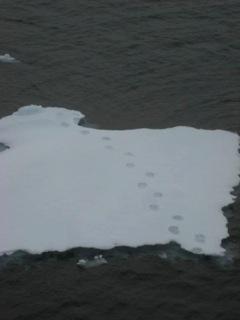The southerly winds over the last few days drove what ice there was south of the polar pack well clear of our last two most northerly stations. The Chief Scientist and the Captain were both quite happy, it allowed for stress free occupation of the two stations, one of which required position keeping for almost seven hours. Ice in the vicinity would have added extra challenge that neither really wanted. Many of the crew were disappointed, hoping as they were for one last chance to be amongst the ice and possibly see a polar bear.
Polar bears generally frequent the ice floes, they need a place of respite like any creature. There have been plenty of signs of polar bears when RV Mirai was in the ice…fresh tracks across ice floes, recent “kill” sites marked by blood soaked snow and ice and remains of the bear’s feast, but no bears were sighted. We are told in this region of the Arctic the polar bear population is doing well and there are no signs of bears fighting starvation as some media seem to report as an Arctic epidemic. The kill sites we have seen certainly indicate someone is getting well fed, but not having the opportunity to sight any, we can not confirm bouncy well fed bears are the norm. We simply know there are bears out there and they are feeding.
We have seen quite a number of walrus over the two weeks we maintained the fixed point observation point. They definitely looked well fed and were very curious about us. Often the biggest of a group would come within 50 meters, raise himself high out of the water and grunt loudly, obviously concerned that we were either on his turf messing with his food supply or were a threat to his harem or family.
We have seen an amazing diversity of life on this cruise from masses of phyto and zooplankton and jelly fish right up the food chain to the signs of polar bears. The Arctic remains a vibrant, living but delicate ocean.
Capt David (Duke) Snider
Ice Navigator
RV Mirai
Photo: Polar Bear tracks across ice floe

